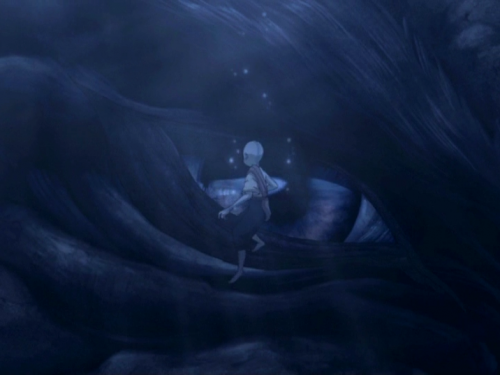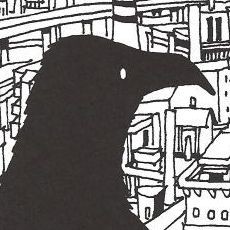Let’s take this Dai Sato discussion for another spin, shall we?
The above image is from the film My Beautiful Girl Mari. It was released in 2001, and is being distributed in the US by ADV films. Moreover, you can stream it for free courtesy of the Anime News Network. It centers around a dream the protagonist has, as a young boy, while staring at a cat’s eye marble. The film is atomospheric, intense, visually pleasing in the extreme and experimental.
If you didn’t notice already, it’s also Korean.
He even accused people in the anime industry of refusing to teach Asian subcontractors special skills or how to craft stories because that would undermine the position of Japan in the production of anime. Non-Japanese are reduced to cheap mechanical labor, and aren’t invested in the work at all. Sato identified this as a major underlying problem with anime today. — Quote from the article in question.
If we’re to believe Sato’s argument, there shouldn’t be any Korean animation. The only animation occurring outside of Japan (aside from Disney and the West, but we’ll get to that later) should be in the studios Japanese animators outsource to. So how is it that My Beautiful Girl Mari, let alone something like the almost too gross to sit through Aachi & Ssipak exist?
What Sato fails to realize is the greater socio-economic implication of outsourcing: the transfer of skills. In continually outsoucring their inbetweening and background art work to Korean studios like DR MOVIE and their Chinese counterparts, they’ve indirectly taught them the art of animation, in the Japanese style. Where did this “Japanese style” come from? From the times when it was cheap to outsource to Japan, and Disney did it, in the same way that Japan is doing it to Korea and China currently. Put in some skill, throw in a different environment, and leave to ferment for long enough, and creative output will inevitably arise. Anime as we know it is a reverberation of outsourcing.
What Sato is predicting isn’t the end of the anime industry, just the end of Japan’s dominance over it. It’s been around two decades since DR MOVIE and its contemporaries in Korea were established, and well over that since the Macross outsourcing that earned Sato’s ire occurred. And only in the last ten years are we seeing original, imaginative Korean animation. Creative people are everywhere, irreverent of political or economic concerns. And, when given the skills, they will create. My Beautiful Girl Mari has some rough edges, but it also has heart, and a willingness to experiment that seem hard to come by in Japan lately. It’s only a matter of time until Korea finds the stories it wants to tell via animation, and the way they want to do it, and then they’ll set off to impress the world.

And so the question arises: is My Beautiful Girl Mari “anime”? Does “anime” belong to Japan alone? I tumblr’ed about this a while back, but things like Avatar: The Last Airbender, while being American in its origins, is undoubtedly inspired by, and draws from the anime tradition, both in its visual and narrative execution.
Sato’s concern is right, and merited. With countries like Korea, and American-born anime like Avatar are increasingly coming onto the market, what does Japan have to offer? When, despite the angry whinging of hardcore fans (and undoubtedly, Japanese executives), when things like Avatar are referred to by non-fans as “anime”, what does that leave Japan with? What about the Animatrix? Or before that, Disney’s 1982 The Last Unicorn, animated in Japan by what would become Studio Ghibli? People like Michael Arias, director of Tekkonkinkreet and elephant-in-the-room foreigner? Does it still count as anime if it’s directed by a white man, even if they’re in Japan?
Anime is changing, and it’s doing it in two ways: the kuukei-kei, or airy/atmospheric (the term lines up best with “slice of life”) anime which seems to be getting more air time is a representation of a commoditization of anime. After nearly 50 years, they’ve found the formula that works. And there’s nothing wrong with that – anime is a business too. It’s also becoming more experimental, however. It’s just that said experimentation may not be occurring inside Japan. For every Tatami Galaxy made in Japan, there’s at least one My Beautiful Girl Mari. As Sato says, “Anime has become a “super establishment system,” where nothing can be changed.” That doesn’t mean they’ll be no creativity within anime, it’s just that the term anime either needs to expand beyond the boarders of Japan, or that creativity in animation will find a home in other countries, and Japan, like America, will be left to produce bad cartoons ad infinitum, until something like Avatar comes along, years later, to liven things up again. The future of anime is brighter than Sato prophecizes, but it may not be anime as we know it.

Leave a Reply